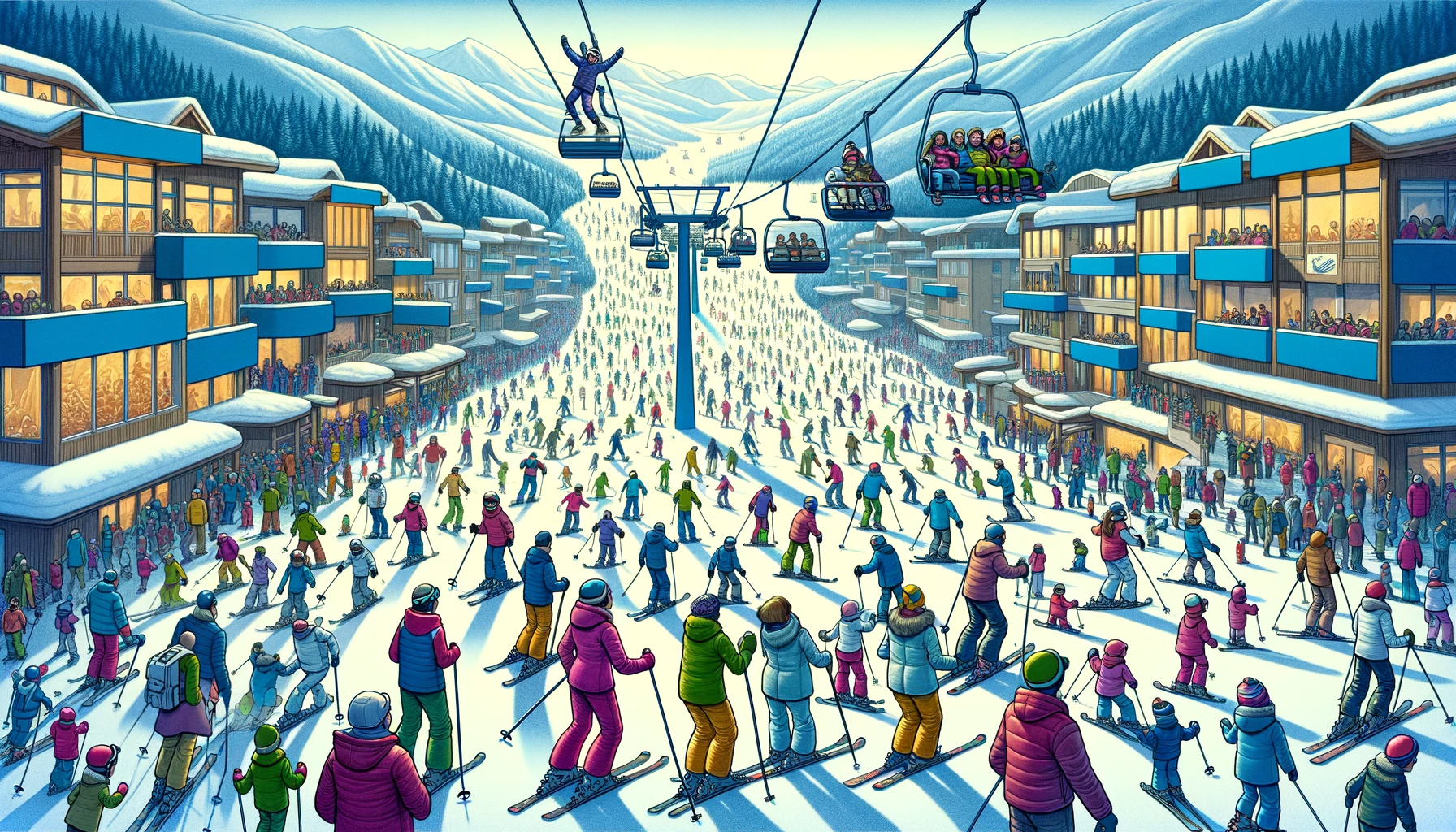Why private equity loves this undervalued sport
Today, we’ve got a cool issue on the world of rugby.
The 2023 Rugby World Cup Final is next Sunday, and it’s no surprise that New Zealand’s All Blacks made it to yet another grand final, where they’ll face reigning champions South Africa.
While US readers have heard of rugby, they’ve probably never watched or played it. But that could change soon.
The US is set to host the 2031 Rugby World Cup for the very first time, and America has a massive opportunity to show the world they’re a force to be reckoned with.
In the meantime, big American private equity dollars are starting to flow into the sport, gobbling up teams left and right.
So it’s time to understand rugby. Why it’s undervalued, why private equity got involved, and how you can invest in the sport too.
Let’s find out 👇
Table of Contents
The National Rugby Football League (NRFL)
In this issue, we’ll show you why rugby is arguably the most undervalued sport in America. It’s growing, but there’s work to do to make it mainstream.
So, how do you take rugby to the next level in the US?
Well, if you’re the NRFL, you focus on awareness and opportunity.
The National Rugby Football League is an up-and-coming professional rugby league built in the United States. Their goal is to take the sport into the stratosphere.

For reasons we’ll get into below, rugby is still considered an amateur sport. If you change that perception, athletes will consider it a real alternative to American Football.
We’ve all seen the power media can have on sports. Just look at what Drive to Survive did for Formula 1 Racing.
- The NRFL is working on a behind-the-scenes docuseries that shows the reality of the sport
- On top of that, they’re working with an Emmy Award-winning director to produce a film based on true rugby stories from the field
- They’re also sponsoring the Alts newsletter (that’s us! har har)
In all seriousness, the NRFL is poised for prime time. And they’re looking for serious investors to join them.
This isn’t a standard investor-operator structure. You’ll own equity in all eight founding teams.
Visit their site. If you’re serious about getting involved. International investors are welcome.
What is Rugby?
Rugby is one of the world’s oldest contact sports.
It was invented in England in the early 1800s by William Webb Ellis (the guy whose name now adorns the world cup.
Well…invented may not be the right word. Ellis was playing soccer when he grew tired of the sport’s “don’t use your hands” rule.
In an act of defiance (or cheating) he picked up the ball, ran past helpless defenders, and simply placed the ball in the goal.
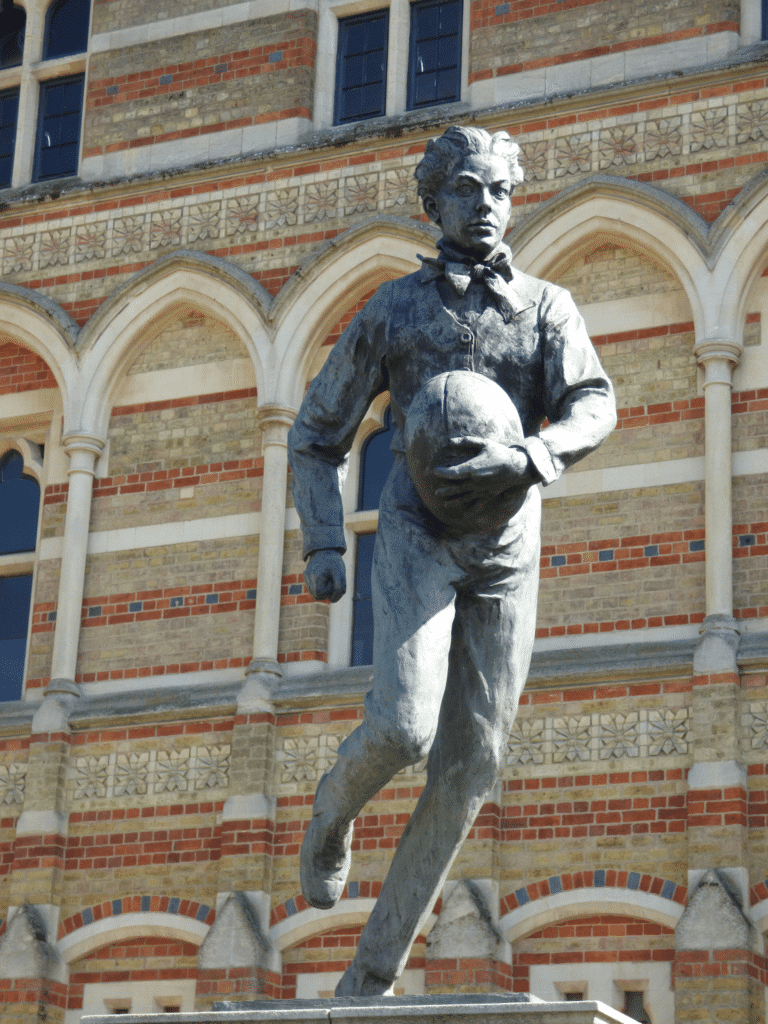
Therein lies rugby’s core — you score by running the ball over a goal line on the other side of the grassy playing field.
The ball can be passed between teammates with a backward (or sideways) throw. But this isn’t like American football — you can’t toss the ball forward. Simple enough.
The catch? Fifteen of the biggest, burliest dudes you’ve ever seen are trying to tackle you.
Where things get really interesting is with the tackle.
Tackling
Tackling is the most important element of rugby.
It’s one of the few sports where play continues after a tackle. When a player with the ball (ball-handler) is brought to the ground, they must immediately release the ball.
The players involved in the tackle — ball-handler or opposition — must “roll away” from the ball to allow a new play to unfold.

In most cases, once you get tackled, your teammates scoop up the ball and continue charging toward the goal line. But if the ball ends up “in dispute,” with players from both teams surrounding it while on their feet, the referee calls something known as a ruck.
Players may not use their hands to touch the ball in a ruck. Instead, rugby becomes a brief, brutal game of “tackle soccer” until the ball spills out and can be picked up by a player.
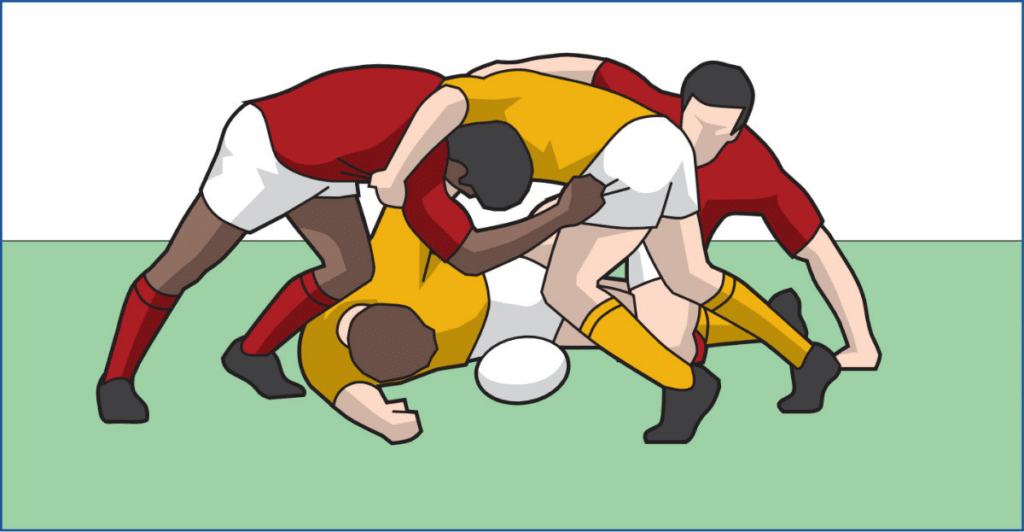
Finally, we have my favorite situation: the aptly-named maul.
I don’t really know how to describe this. The ball carrier is essentially surrounded by teammates in a giant wall of death, where everyone pushes a tangled mess of humans forward as far as possible.
Sheer power, mass, and muscle. A maul is equal parts ridiculous and jaw-dropping.
Just watch:
How popular is rugby?
Rugby is a top-ten world sport.
Over 130 nations are members of rugby’s governing body, including the US. It has annual viewership of close to 500 million — that’s on par with baseball and golf.
Like with cricket, Rugby is popular across the Commonwealth nations. England was first on the scene, but the real capital of rugby is New Zealand. 1.7 million New Zealanders watch rugby. It’s the Kiwi’s national sport and plays a massive role in their culture.
In fact, before we go any further, we must talk about the All Blacks.
Who are the All Blacks?
If there’s one team you need to know about in rugby, it’s the All Blacks — one of the most iconic sporting teams in the world.

The All Blacks are in the World Cup this year. They’re in the World Cup most years. With three titles, one runner-up finish and 49 wins to their name, New Zealand is the most successful team in Rugby World Cup history.
In fact, they’re often considered the single best team from any sport, period. They’re like the Yankees times the Patriots times the Lakers.
The All Blacks aren’t just a team playing in a league. The cultural roots run extremely deep, as they represent all of New Zealand. Whether it be the ceremonial performance of The Haka or the silver fern frond on the emblem, they are an instantly recognizable brand.
By the way, if you’ve never seen The Haka, it’s time to change that, right now:
The All Blacks are worth over $2 billion. In a country of just 5 million people, these are serious numbers. (To put this in perspective, The UK has roughly the same viewership numbers with 10x the population.)
This is part of the reason why American private equity has gotten involved.
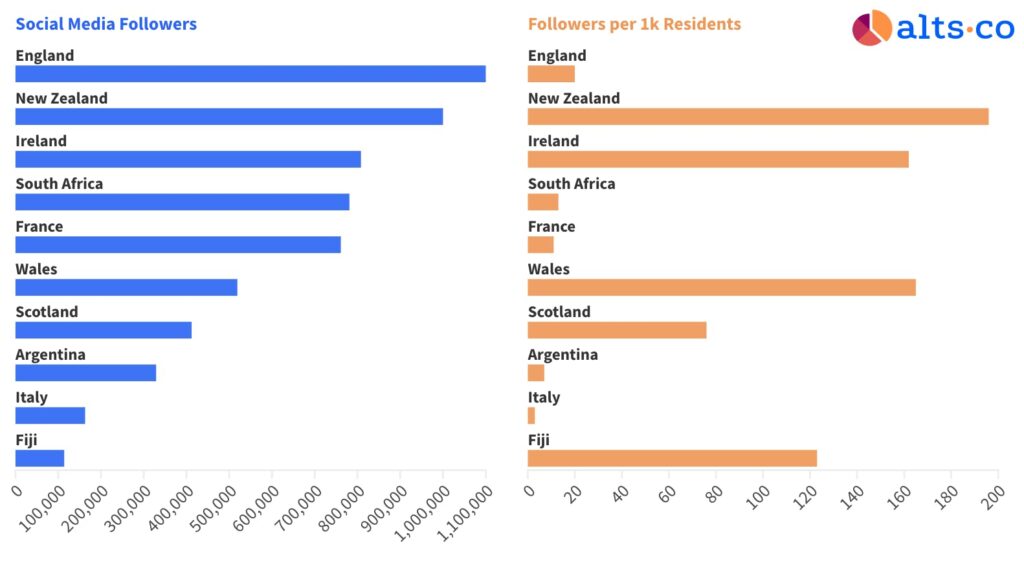
The business of rugby
Rugby took a long time to professionalize
Rugby has been around for three centuries. But it’s only been a professional sport since 1995.
Don’t get me wrong, there’s always been money in rugby. But for years, players weren’t getting a lick of the profits from World Rugby, (rugby’s governing body).
Why?
Because the international clubs didn’t pay their players!
It’s true. If you played rugby for a national team, you didn’t get paid. They claimed they couldn’t afford to pay, and players who dared to get compensated were given life bans.
But with smaller, private rugby leagues threatening to poach rugby’s top players, nations had to pony up or die.
So, all one hundred body members voted in favor of making rugby a professional sport, leading to the normalized, paid environment we have today.
By 2019, the sport appeared to have climbed the mountain. World Cups had transformed from a small amateur competition into a tournament with a $4.56 billion output in under 3 decades. (For context, the FIFA World Cup, the world’s largest sporting tournament, brings in about $17 billion for its host nation.)
Covid exposed rugby’s financial difficulties…
Because rugby was late to professionalize, it lacks the same sponsorship pull as its competitors. For example, the English Premier League rakes in $2 billion per year for broadcast rights, whereas Rugby Union’s broadcast revenue is fairly low — just $45 million.
Rugby was one of the most highly impacted sports during covid, with several of the world’s biggest leagues shut down, paused, or played without crowds.
- During covid, rugby nearly fell off a cliff. Australia recorded a $27 million deficit . Things got so bad they considered returning the sport to its amateur roots (aka, not paying their players again).
- Just down the road, rugby’s GOATs were facing a similar disaster. The New Zealand All Blacks administration had chewed through half of their cash reserves. Bankruptcy appeared to be a legitimate threat.
- Even today, rugby’s homeland of England is still reeling from the effects of covid. Professional clubs with rich histories simply vanished after the pandemic.

…then private equity stepped in
Rugby had to adapt to prevent the collapse of everything it had built over the past 25 years. Teams, athletes and governing bodies had to take a long, hard look at their financial structure.
The solution? Private equity.
If you’ve been following us, you know that private equity has been gobbling up sports teams.
Facing financial difficulties, rugby clubs (and leagues) opened their arms and got the financing they needed to keep the sport alive.
The biggest example was New Zealand’s All Blacks. It’s almost unheard of for private equity to wrangle minority ownership of a national sports team — especially one as prestigious as the All Blacks.
But that’s exactly what PE firm Silver Lake did in 2022 when they purchased a 5-8% stake for NZ $200 million. Funds were immediately injected into salaries, local competitions and clubs. Silver Lake’s return comes mainly from TV rights and sponsorships, which they valued at US $2 billion.
And that was just the beginning.
Rugby in the United States
The seeds have already been planted, and The United States is primed for a rugby explosion.
At the grassroots level, rugby in the US is thriving. There are 110,000 registered players, and 1.5m people playing casually each year. It’s on par with ice hockey, and (incredibly) isn’t all that far behind American football.
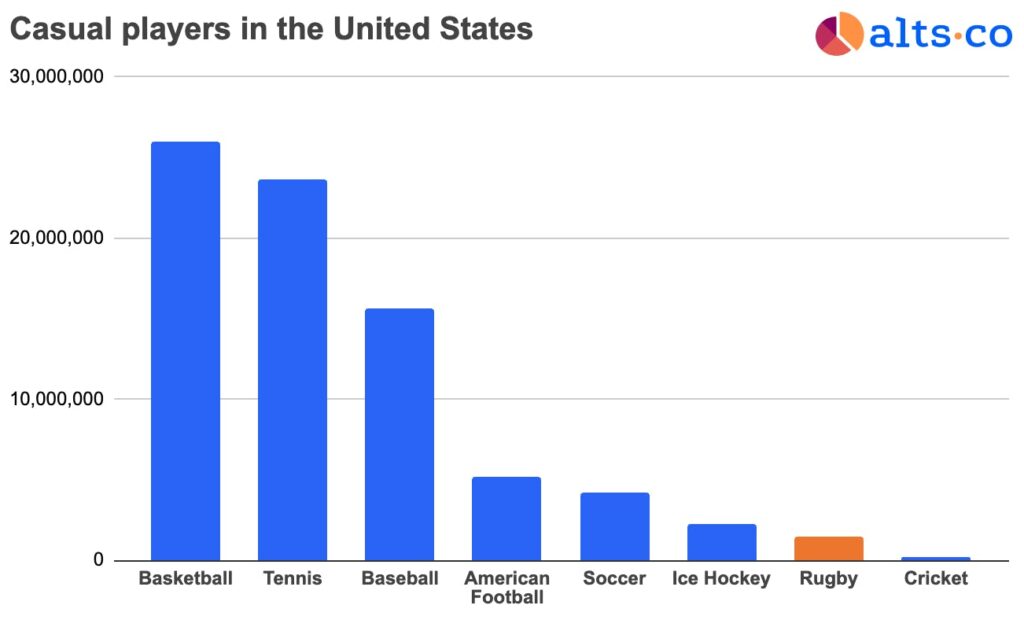
The 2023 Rugby World Cup has brought a cool 400,000 new US fans to social media channels. And as America prepares to host the RWC for the first time, let’s recall how impactful being the host country can be.
We saw what happened in 1994 when America hosted soccer’s World Cup. The tournament’s $50 million surplus kept the US Soccer Organization alive. It also helped fund Major League Soccer, which as we know has since become a soaring juggernaut.
Rugby vs American Football
So, amateur rugby is alive and well in the United States. But what’s standing in the way of it becoming a professional sport
Well, there’s no denying that American Football is the number one sport in the US. It’s growing both domestically and internationally, and is now the highest-revenue individual sports league in the entire world. Many would point to the NFL as the reason for rugby’s (relative) lack of popularity.
But in reality, there’s no reason the two cannot co-exist.
In fact, rugby is well-positioned to avoid some of football’s problems, and ride some of its coattails.
- History. Americans love tackle sports and rugby is the original tackle sport. Americans actually played rugby for decades before US football was invented.
- Trends. Despite the hype, participation in American Football has been decreasing since 2010. Meanwhile, participation in rugby is increasing.
- University teams. College rugby is one of America’s fastest-growing club sports, with over 900 men’s and women’s teams sprinkled throughout the nation.
- More equitable/better suited for kids. Rugby is better suited as a youth sport than American Football. While there’s plenty of debate about which sport is safer, rugby is inarguably more equitable. There are fewer strict roles, no changing teams for offense or defense, and less “standing around.” Anyone can tackle, anyone can score.
- Abundant supply of players. About 1,200 athletes are cut from the NFL each year. Today, most of these folks end up playing amateur football for the rest of their careers. But as rugby’s star rises, these players could join a pro rugby league and shine.
Is rugby undervalued?
What’s most interesting to me though is the delta between rugby’s popularity and revenue.
The foundation for rugby to flourish has already been established. It’s one of the most popular sports (with over 877 million fans) but accounts for less than 1% of global media rights!
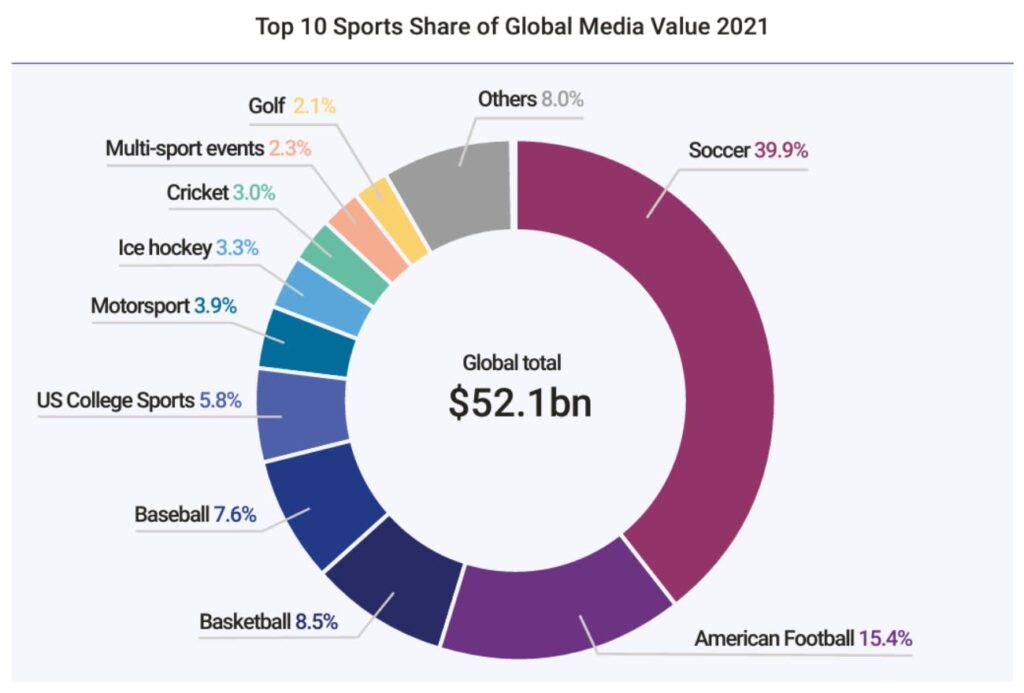
Think about that for a moment. Sponsorship revenue is based on eyeballs. If you have the viewers, the dollars will follow.
Right now, the market is implying that rugby’s eyeballs aren’t “worth” as much as in other sports. But that’s because the industry is under-utilized. Thanks to a poorly managed history, rugby sponsorships are not (yet) an efficient market.
Once it becomes one, watch out.
Closing thoughts
Winston Churchill described rugby as a “hooligans game played by gentlemen.” It’s a beautiful, chaotic game of skill, strategy, and raw power.
Whether or not you’re familiar with the sport, one thing’s for sure: Rugby is one of the most under-commercialized sports in the world.
It’s not an alternative sport, but it’s not mainstream yet either — at least not in the US. It’s also undervalued relative to eyeballs, which means it’s a compelling opportunity for both value and growth investors.
You can’t help but get excited about the growth potential. Heck, just look at what happened with New Zealand’s All Blacks.
New Zealand’s population is so tiny (5 million people) that sheep outnumber humans 6:1. But after Silverlake’s investment, the All Blacks are now valued at $2 billion. That’s $400 per person. For a single team. That’s the power of American investment.
America has the capital, talent, infrastructure, “tackle sport” fan base, media, betting, and a population that’s 60 times bigger than New Zealand’s.
Imagine what the USA will do with this sport. 🏉
Further reading
- Be sure to watch the Rugby World Cup next Sunday (And root for the All Blacks!) Here’s where you can watch it.
- Last year I wrote about how PE is gobbling up sports teams. Last month, Wyatt opined in The WC. PE shows no signs of slowing down.
- Andrew Petcash from Profluence shared some good rugby stats on LinkedIn.
- To stem serious injuries, the NFL is looking to ban the “hip drop tackle” (which rugby already disallows)
- An Amazon Prime documentary called The Story of Rugby covers how the game transitioned from amateur to pro, and hurt smaller clubs who now had to pay the players.
- World Rugby itself has some anecdotes from the meeting that took rugby professional.
- Finally, the national anthems and electrifying war cry of New Zealand and Samoa are truly moving.
Disclosures
- This issue was sponsored by The NRFL and WebStreet
- Neither the author nor our ALTS 1 Fund holds any interest in any companies mentioned in this issue
- This issue contains no affiliate links







